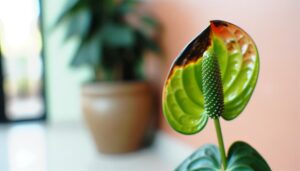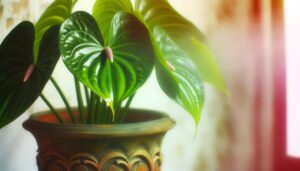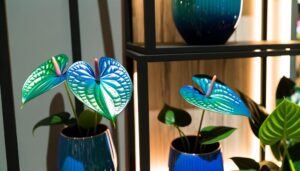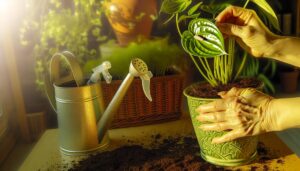How to Treat Yellow Spots on Anthurium Plant Leaves
Yellow spots on your anthurium leaves often indicate issues like nutrient deficiencies, particularly nitrogen or magnesium. Check the soil pH, aiming for a slightly acidic range, and consider using chelated micronutrients.
Inspect the plant for pests like spider mites or aphids, treating infestations with insecticidal soap. Ensure your watering schedule is consistent, using tepid, filtered water, and that the soil drains well.
Maintain bright, indirect light levels, avoiding direct sun exposure. Regularly monitor and adjust care practices to keep your anthurium vibrant.
To uncover thorough treatment methods and preventative tips, there's more information available.
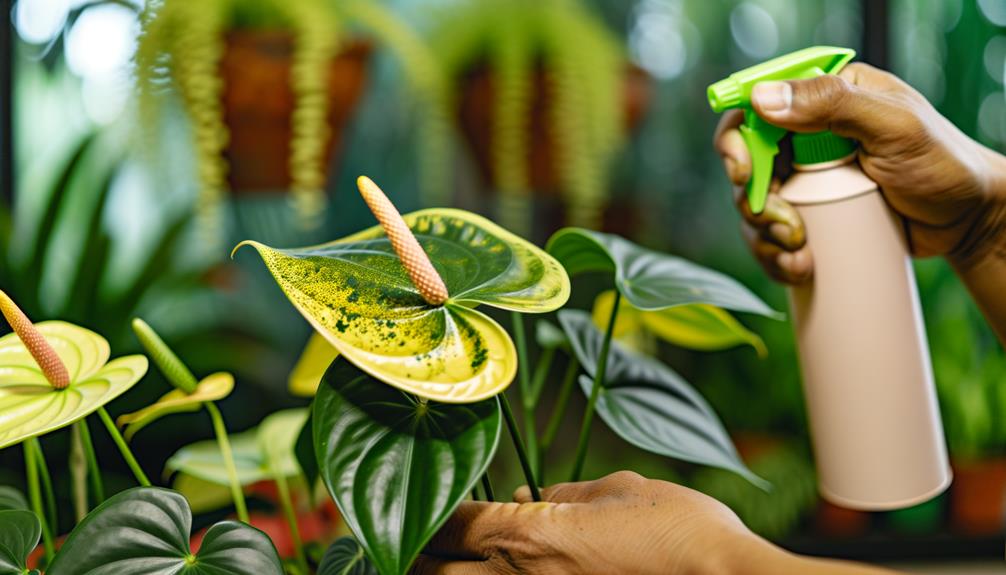
Key Takeaways
- Check for nutrient deficiencies, especially nitrogen and magnesium, and use a balanced fertilizer.
- Inspect for pests like spider mites and aphids, and treat with insecticidal soap.
- Ensure proper watering techniques, using tepid, filtered water and well-draining soil.
- Adjust soil pH to the optimal range for nutrient uptake.
- Provide bright, indirect light, avoiding direct sunlight to prevent leaf scorching.
Identify the Causes
To effectively address yellow spots on Anthurium leaves, you need to first identify the underlying causes which can range from nutrient deficiencies to pest infestations.
Start by examining the foliage closely. Yellow spots often indicate chlorosis, typically caused by a lack of essential nutrients like nitrogen or magnesium. Check the soil pH; Anthuriums thrive in slightly acidic to neutral conditions. If the pH is off, nutrient uptake can be impaired.
Inspect the leaves for pests such as spider mites or aphids, which can cause localized damage. Use a magnifying glass for a thorough inspection. Additionally, consider any recent changes in lighting conditions, as improper light can also stress the plant.
Accurate diagnosis is essential for effective treatment.
Proper Watering Techniques
After diagnosing the underlying causes, ensuring proper watering techniques is essential for preventing yellow spots on Anthurium leaves. Start by using tepid, filtered water to avoid chlorine and fluoride damage.
Water the Anthurium when the top inch of soil feels dry; overwatering leads to root rot, while underwatering causes leaf desiccation. Employ a well-draining soil mix, such as one containing peat, pine bark, and perlite, to maintain ideal moisture levels without waterlogging.
Always use a pot with drainage holes to prevent stagnant water accumulation. Additionally, maintain a consistent watering schedule and monitor humidity levels, ideally between 70-80%.
Nutrient Management
Ensuring proper nutrient management is essential for preventing yellow spots on Anthurium leaves, as imbalanced fertilization can lead to deficiencies or toxicities affecting leaf health. You should use a balanced fertilizer with an N-P-K ratio of 20-20-20, applied every 4-6 weeks during the growing season.
Monitor for signs of nutrient deficiencies like chlorosis, often indicative of nitrogen or magnesium shortages. If yellow spots persist, consider conducting a soil test. Adjust pH to the most suitable range of 5.5-6.5, facilitating nutrient uptake.
Micronutrient deficiencies, such as iron or manganese, can also cause yellowing; use chelated forms of these minerals for quicker absorption. Always follow manufacturer guidelines to prevent over-fertilization, which can exacerbate the problem.
Pest and Disease Control
Identifying and managing pests and diseases is important for maintaining the health of your Anthurium plants and preventing yellow spots on their leaves. Regular monitoring is essential to detect early signs of infestation or infection.
Here's a structured approach:
- Inspect Weekly: Examine leaves for aphids, spider mites, or scale insects. Use a magnifying glass for detailed observation.
- Apply Insecticidal Soap: If pests are present, treat with a horticultural soap, making sure thorough coverage of affected areas.
- Fungal Control: Treat fungal issues like Anthracnose with a fungicide containing copper or sulfur. Ensure good air circulation.
- Isolate Affected Plants: Prevent the spread of diseases by isolating infected plants until they recover.
Following these steps will help maintain healthy Anthurium foliage.
Optimal Light Conditions
To safeguard your Anthurium thrives, provide bright, indirect light, as direct sunlight can scorch the leaves and cause yellow spots. Place your plant near an east or north-facing window where it can receive ample light without the risk of burning. Use sheer curtains if necessary to filter the sunlight effectively.
Here's a quick guide:
| Light Condition | Description |
|---|---|
| Bright Indirect | Near a window, filtered sunlight |
| Direct Sunlight | Risk of leaf scorching |
| Low Light | Insufficient for thriving |
Research indicates that Anthuriums also adapt well to artificial grow lights if natural light is limited. Make sure consistent light exposure for at least 6-8 hours daily. Regularly rotating the plant ensures even light distribution, preventing yellow spots caused by uneven lighting.
Conclusion
By addressing yellow spots on your anthurium leaves, you're not just tending to a plant; you're nurturing a symbol of your dedication to the art of horticulture.
Remember, precise watering, balanced nutrients, vigilant pest control, and best light conditions are your tools. Like a skilled artisan, you craft a thriving environment.
With each healthy leaf, you're painting a living masterpiece, grounded in research and expertise. Embrace this journey, and let your anthurium flourish.


